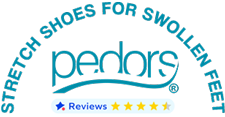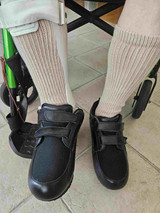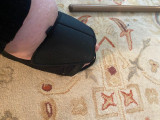Insurance For Orthopedic Shoes - The Shortfalls

Insurance
One of the most common inquiries we encounter at our Fantastically Functional Footwear company
is whether Pedors are covered by insurance for a particular medical condition
that affects a person’s feet and by extension the choices they make in the
shoes they are recommended to wear.
Unfortunately, the only condition that Medicare covers under fairly strict qualification criteria is diabetes, where the diabetic is considered at risk for ulceration. The rest of the insurance providers tend to follow suit, although it never hurts to ask you provider if they offer coverage for your particular condition.
It can be very frustrating dealing with medical insurance companies for many as non coverage doesn’t make sense for many people living with medical conditions that necessitate appropriate orthopedic footwear, where normal shoes not only don’t work for them, but can often manifest into serious issues by wearing unsuitable and ill fitting shoes.
If you are looking for footwear solutions for any of the conditions listed below, Pedors Fantastically Functional Footwear might be able to help. Of course we can’t guarantee anything as each individual’s condition is different, all we can say is that if you review the consumer reviews posted on the site, verified by Yotpo™ (real testimonials) they may help you to decide whether it’s worth a try.
If you do decide to try one of our products, to help offset the lack of insurance coverage, we’ve created a special discount code. Enter LAMEINSURANCE at checkout for a pleasant surprise.
Rheumatoid arthritis, swollen feet, and lymphedema - are the three conditions we hear the most about.
Orthopedic shoes might be FSA/HSA/HRA eligible (with a Letter of Medical Necessity).
Arthritis
Deformed arthritic feet need to be accommodated in shoes in
order to eliminate pressure points that can cause pain and other issues. The
Pedors Classic is our most popular shoe worn by people living with
arthritis in
their feet. The stretch material we use called Pedoprene™ can be easily “spot
heat molded” to relieve those pressure points in extreme cases. For most
instances though the Pedoprene™ provides enough stretch to make the fit
comfortable.
Edema
For people suffering with edema, finding footwear that can
accommodate feet that swell over the course of the day requires materials that
can not only stretch but can offer some compression as well. The fit of the
shoe also needs to be easily adjusted during the day. People that suffer with edema and lymphedema
tell us how the Pedors Classic Max available in multiple widths up to 6E, has
helped them get back on their feet again. The Pedors Classic Max has become the shoe of
choice for people looking for
shoes for swollen feet.
Raynaud's Disease
Not as common, but equally as debilitating is a condition
called Raynaud’s disease or Primary Raynaud’s, where blood vessels in the hands and feet
appear to overreact to cold temperatures or stress, resulting in fingers and
toes going into vasospasm temporarily limiting blood supply. Secondary
Raynaud’s is less common than the primary form but tends to be more serious and
is caused by an underlying problem. Connective tissue diseases like
scleroderma, lupus, rheumatoid arthritis and Sjogren’s syndrome all increase
the risk of Raynaud’s. Diseases of the arteries where there is a buildup of
plaques in blood vessels that feed the heart (atherosclerosis) or a disorder
where the blood vessels of the hands and feet become inflamed (Buerger’s
disease) can be linked to Raynaud’s. Keeping feet and hands warm with products
that insulate well help avoid the onset of a Raynaud’s attack. Pedoprene™ is a
blend of neoprene and EVA which have excellent insulation and molding
properties that help keep feet warm.
Scleroderma
Scleroderma, which literally means hardening of the skin, is
a chronic connective tissue disease classified as one of the autoimmune
rheumatic diseases. The effect of scleroderma can range from very mild to life
threatening, dependent on the part of the body affected and the extent to which
the organ is affected. The exact cause or causes of scleroderma are unknown but
it involves the overproduction of collagen and currently there is no cure for
it. There are two forms of scleroderma, localized and systemic. Generally,
localized scleroderma is relatively mild and are found in only a few places on
the skin or muscles and rarely spread elsewhere and internal organs are usually
not affected.
Systemic scleroderma also known as systemic sclerosis, indicates that hardening may occur in the internal systems of the body. There are two major patterns that the illness can take - diffuse or limited disease. Diffuse is the more dangerous of the two where skin thickening occurs more rapidly and involves more skin areas than in limited disease. Diffuse scleroderma has a higher risk of developing sclerosis or fibrous hardening of the internal organs. In limited scleroderma skin thickening is typically confined to the fingers hands and face and develops slowly over the years. Although limited scleroderma is less severe, limited scleroderma is more likely to develop pulmonary hypertension where the lungs blood vessels become narrow leading to impaired blood flow through the lungs resulting in shortness of breath.
As scleroderma relates to your feet and shoe choices, you may experience hardening of the skin first noticed as morning redness and puffiness in your toes with edema or swelling in your feet which, combined with the gradual development of immobility of the skin over underlying tissues, can lead to ulcers over bony prominences in the foot. Shoes that can be spot stretched or heat molded over areas of contracted toes should be considered. Extra depth shoes allow for the insertion or removal of inserts to accommodate from inflammation from morning to evening and that offer some insulation value for patients that experience Raynaud’s. Extra depth shoes that have room for accommodative inserts that mold to the patient’s foot to limit sheer forces in the shoe caused by ill fitting shoes and evenly distribute weight to eliminate plantar pressures and to off load pressure points caused by bony prominences, also reduce the incidence of trauma to the foot for people with scleroderma.
Stephen O'Hare
President
Pedors Shoes
Explore Popular Articles
I would encourage you to buy Pedors, you will not be sorry that you did.
Why I Wear Pedors - by Bill B Do you mind sharing in general terms your primary foot issue or issues...
I love my Pedors Sandals
I love my Pedors Sandals, by Sandy W Because of lymphedema in both legs and feet, I have not been...
Tell Your Pedors Story #5 - Carlo and Pedors
Do you mind sharing in general terms your primary foot issue or issues? Since early 2023, I have suf...
Tell Your Pedors Story #4 - Debbie S
Hi, my husband has swollen feet and legs. He was not able to put his feet into shoes. I spent hours...
Tell Your Pedors Story #3 - Donna J
Tell Your Pedors Story #3 - Donna J - Shoes For Lymphedema and Lipodema After reading Donna's amazin...
Tell Your Pedors Story #2 - Mildred and Penny D
Wedding Shoes For Swollen Feet Penny conversed with me over email after I reached out to her mothe...



